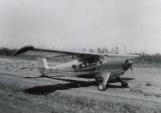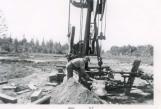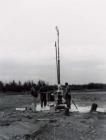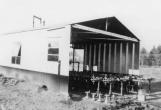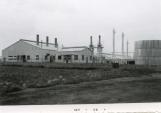15
Luckily, driving was not the only way into the camp."We had an airstrip at the campsite and I remember whan a hand got sick and a plane landed to take him to Edmonton. I also recall when several inches of hail accumulated on the strip from summer hailstorms."
17
In the town site of Cynthia I believe that 10 or 12 new houses were built for the employees (of Texaco) in 1957. In 1958, a hotel with a cafe and Andy's garage were opened.18
As a summer student Art Irwin's training consisted of working with Martin Seirer and Dan Claypool (see Black Gold Pioneers for more stories on Mr. Claypool).His work was largely that of oilfield maintenance.
20
Leveling pump jack bases was quite a task and was overseen by head roustabouts Dan Claypool and Martin Steirer.The job of leveling the concrete base pads involved jacking the base up by using a chain, a piece of drill stem, and several large wooden blocks; then shoveling gravel under the concrete pad until it was level.
Obviously this didn't last very long as the muskeg under the pad gave away in a few days and the exercise had to be repeated.
22
Cleaning up the leases, similar to this one was performed by the roustabout crews.In one case near Breamar B battery, the Leduc Construction cat skinner who was assisting, looped the winch cable around a piece of pipe protruding above ground and gave a suck to pull it free. He snapped off the pipe which was the flow line from the well to the battery and oil flowed forth at a good rate.
He quickly shut off the main valve at the wellhead, but the oil continued to flow back downhill from the storage tank at the battery. He then proceeded to the battery to isolate the line.
In the meantime a good amount of crude oil accumulated on the lease. A cleanup job ensued and the ERCB was not overly impressed.
This is Leo Boltoff standing at the wellhead.
24
In 1958, I was operating Jack Burt's bottom hole pressure test rig which included a bunwagon van, 1,000 feet of wireline, and various other paraphernalia including an echometer for testing pumping wells. We inserted a pressure buildup test bomb down this well on a Friday before a long weekend to measure static pressure build up at the well formation. On Tuesday, we were unable to retrieve the bomb as we found it stuck on the bottom, some 5,200 plus feet downhole.After yanking very hard, the bomb came free and we pulled it to the surface. We determined from the line counter that we were about 5 feet short on the pullout. This was verified when it was determined that the bomb was located in the main shutoff gate valve when the wireline reached end of travel.
This was a new well with good flow and pressure (some 600 psig). Several alternatives were considered to recover the bomb- most of which involved killing the well and fishing the bomb out of the well. A service company was hired to recover the bomb by freezing off the wellhead.
This involved dropping the bomb just below the main shufoff valve which was closed up to the wireline; then cutting the flowline to allow drilling mud to be pumped into the wellhead, filling it to the main valve. A tin container was built around the wellhead, filled with dry ice and let sit to freeze solid. Meanwhile an extra long lubricator was built to replace the standard length unit. After a couple of hours the bleed valve was opened to atmosphere with no pressure indicated in the wellhead. Then we gingerly removed the standard lubricator and stuffing box from the wellhead, cut the wireline and threaded it through the long replacement lubricator and stuffing box, and placed the new assembly on the wellhead. The dry ice was removed from the wellhead. This is indicated in the picture by the white fog. The well head thawed out and the bomb was recovered.
A simple knot was found in the wireline about 3 feet from the pressure bomb. This was caused when the bomb was jerked free from sand build up in the bottom of the 4 inch diameter flow string. The bomb rose up and fell through a loop in the wireline which normally coils if given any slack. I still have the wire knot.
The well was saved and Jack Burt still had 10,000 feet of wireline, less a few feet (rather than 2- 5,000 foot pieces).
26
This battery was expanded in 1957 by the roustabout crews headed up by Dan Claypool and Martin Steirer. The addition included new 3 way valves piped into 3 headers and manifolds to accommodate two test treaters and one main treater. This is all 3 inch and 4 inch screwed pipe and fittings.Frank Pasay and I worked on one header and Steve Pohonski and Red or Leo worked on the header on the other side. When we got to the end where the headers were to be connected by a crossover pipe, our side was about 3 inches shorter and some adjustment was required. Needless to say, Frank and I had several fittings which had to be replaced- Frank always said they were faulty fittings.
